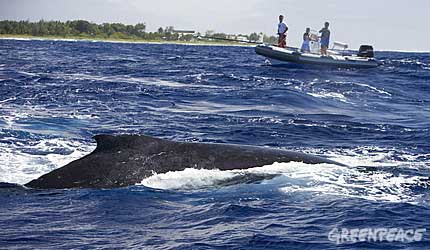
Greenpeace has linked up with two scientific research bodies, Cook Islands Whale Research and Opération Cétatés, to tag and track humpback whales as they migrate from their breeding and calving areas in the tropical South Pacific to the feeding grounds of the Southern Ocean.
We are funding the project, which recently started tagging humpbacks in the waters off New Caledonia and the Cook Islands. 20 whales have so far been tagged, allowing them to be tracked by satellite. This is the largest operation of its kind so far attempted, and should provide important new information on their movements and migratory destinations over the coming months.
One of the key reasons behind the project is to show how much research data can be gathered without harming any whales, and undermine the Japanese Fisheries Ministry's rationale for so-called 'scientific whaling' (which is really commercial whaling in disguise). Every winter their whaling fleet heads down to the Southern Ocean to kill minke and fin whales in the name of science, even though meat from the dead whales ends up being sold in supermarkets. This year, for the first time, they plan to add 50 humpbacks to the list, but we'll be sending our largest, fastest ship, the Esperanza, to make life as hard as possible for them.
Now for the first time, thanks to the technological miracle that is Google Earth, you can watch the humpbacks' progress by following our Great Whale Trail. And before you ask - no the Japanese whaling fleet won't be able to make use of this information - the data posted on the maps is correct, but is only published a day after first being received, making it useless for hunting purposes.



